MDR-7509HD
back to Sony
back to measurements
home
published: Nov-24-2021, updated: Nov-23-2023
NO SMOOTHING is applied to the shown plots. Most measurement sites have some smoothing applied which ‘irons flat’ sharp peaks and ‘wiggles’. I do not use smoothing because some info about sound quality is lost when plots are smoothed.
Aside from a small correction of the microphone itself also some correction in the lowest frequencies is applied to the plots to compensate for the perceived loss of bass when using headphones. This is described HERE in more detail.
A ‘horizontal‘ frequency response curve on the shown frequency response plots on this website thus indicates a perceived ‘flat’ tonal signature.
ALL measurements are made with a good SEAL on a flatbed measurement rig.
The shape of your head, bone structure, pad size, pad ‘softness, (compliance), hair or no hair and or wearing glasses may (drastically) change the frequency response of some headphones, so… your personal experience may differ substantially from these plots.
Frequency response (tonal balance) is the most sound-determining aspect of headphones. A horizontal line shows audible neutral response in the plots on this website. Deviations in different severities at different frequency bands have an effect on the sound character.
The bigger the deviation the stronger the effect.
Below an aid to help determining the sound character of headphones with relation to the frequency response.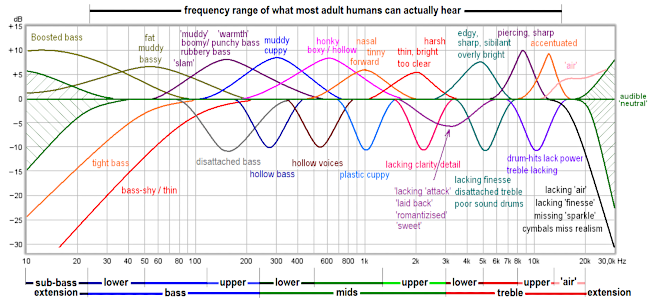
Sony MDR-7509 HD
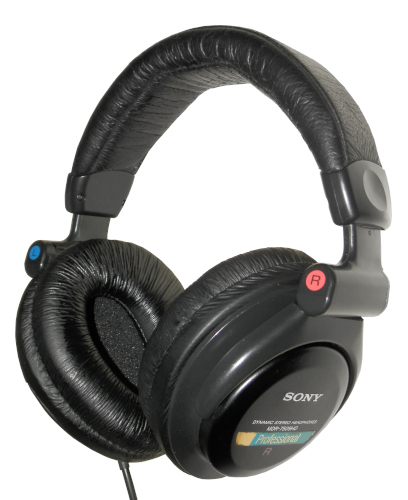
The Sony MDR-7509 HD is a closed over-ear headphone. When this headphone came out (around 2011 as successor of the MDR-7509) the MSRP was around € 160.- It was only sold for a couple of years and was intended for the professional market.
Some complaints arose about the MDR-7509 to have boomy bass and these HD versions were Sony’s answer to the criticism. It came with a soft carrying pouch.
The 3m coiled cable is mildly microphonic so in quiet passages and silences the cable rubbing against clothes are barely audible in the left cup. The cable is fixed so cannot be replaced.
The headband has a soft pleather padding so after a few years of usage one can expect it to flake.
The headband can extend 40mm and is notched so after adjusting stays in place.
The cups can swivel and tilt just far enough to get a good seal on most (but probably not all) head sizes. Also he headband itself is quite flexible so this headphone will fit on most head sizes. Clamping force is medium (3N) but because of the large contact surface of the pads it feels as if little pressure is there. Its weight of 300 gram (without cable) also is quite decent.
The thin pleather pads are exchangeable and feel soft to the touch. After a while they feel sweaty and warm. The pleather will flake and fall apart after some time so be prepared to buy pads now and then.
It is a closed headphone and outside noises are decently attenuated. Of course this also works the other way around so while listening to music those around you will not be bothered.
With a sensitivity of 120dB/V (efficiency = 107dB/mW) and low impedance (25 Ω measured) this headphone plays very loud even directly from a phone.
The power rating is quite high for a PRO headphone. 3W continuous means it can lay on a desk and you can basically use these as small, bass less speakers (not recommended though).
specifications:
Type: Over ear (circum-aural), closed
Usage: Home, studio, portable
Driver type: dynamic
Pads: replaceable, thin pleather, regular foam, ear shaped
Collapsible: yes
Headphone cup connector: fixed
Cable entry: single sided (left).
Cable: 3m coiled in a 3.5mm TRS jack with a 6.3mm screw-on adapter
Inner Pad dimensions: depth = 20mm, height = 55mm, width = 30mm, pinna shaped.
Driver size: 45mm (effective area, driver diameter = 50mm)
Nom. power rating: 3W
Max. voltage: 8.5Vrms (24Vpp)
Max. current: 340mA
Max. S.P.L.: 135 dB
Impedance: 25 Ω (measured)
Efficiency: 104dB @ 1mW
Sensitivity: 120dB @ 1V
Weight: 299 g. (without cable)
Clamping force: medium 4N
Accessories: soft carrying pouch
Subjective sound description:
Bass shy, midrange centric with treble at the proper level but of mediocre quality. This headphone clearly is intended for monitoring purposes. For this task it works well. Bass sounds light but tight and puchy. Mids are what this headphone is all about. Treble is on the proper level and not bright, sharp, smooth or subdued. Alas for hi-fi fans looking for a professional headphone this isn’t it.
Treble quality is low and bass is missing. Mids also aren’t hi-fi quality. All these aspects though are not important for monitoring though.
Measurements:
Below the frequency response of the MDR-7509HD (Left, Right)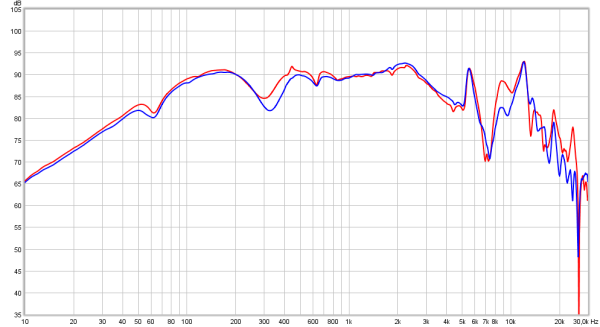
The channel matching is decent. Bass extension simply is not there. Low bass also is subdued but high bass is there and at the proper level. It gives the bass a ‘tight’ and punchy character. The range between 300Hz and 3kHz (vocal range) is at slightly forward ‘neutral’ level.
Alas from 3kHz upwards the response is messy which translates in poorer details. The sharp 20dB dip cannot be EQed and lowers the treble quality but at least there is no sibilance and sharpness which is pleasant when monitoring at louder levels.
compared to MDR-7509
Below the difference between the MDR-7509 and the MDR-7509HD These are very different sounding headphones.
These are very different sounding headphones.
phase response
Below the phase response of the MDR-7509HD (Left, Right)

Slow phase shifts are not very audible. Sharp changes in a narrow frequency bands may well be audible. The sharp rises at 4.5kHz and above may well be audible and also responsible for the perceived lesser sound quality of the treble.
output resistance / damping-factor
As this is a dynamic headphone the frequency response can be amplifier output resistance dependent when certain higher output resistance amplifiers are used.
Instead of showing impedance plots, which are hard to ‘read’ when it comes to assessing the tonal balance change in the real world, the MDR-7509HD is measured via a few different resistance outputs (0.2Ω, 10Ω, 32 and 120Ω). On a higher output resistance amplifier the output level will be lower of course due to voltage division. To compensate for this the amplifier is cranked up to the same level (15dB for 120Ω at 1kHz in this case). This way the plots are overlaid and it is easier to see how the tonal balance changes. Output resistances between the mentioned resistance values will result in tonal changes between those traces.
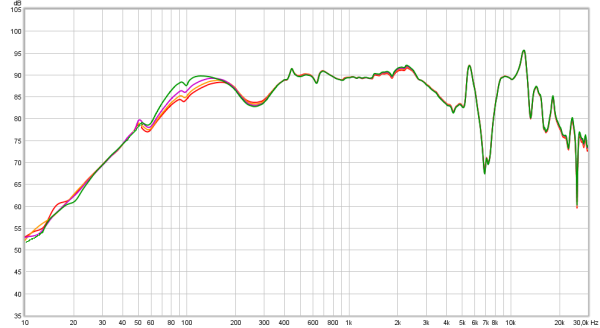
The tonal balance in the bass changes when a higher output resistance amplifier is used so it seems but during the test itself the amplitude is lower (due to voltage division) so it would seem as though bass is higher on 120Ω but the amplitude has dropped to 80dB. With most headphones the amplitude at 80dB and 90dB SPL is about the same (opposite 1kHz) but this is not the case here. So part of the bass increase we see is not caused by the impedance alone but also due to compression at SPL levels above 70dB in the lows as seen below.
Linearity
The headphone is measured 4 times. Once at 70dB, 80dB, 90dB and 97dB SPL. When the traces are the same shape then there is no compression which, sadly, is not the case here.
This will be more clearly visible when overlaid and amplified in vertical scale (2dB/div) in the plot below. 70dB, 80dB, 90dB and 97dB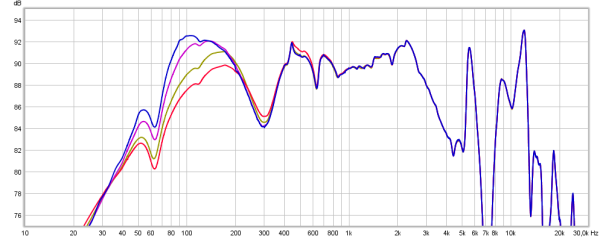
At 97dB the bass levels at 100Hz are 4dB lower than at 70dB indicating there is substantial soft clipping which already starts above 70dB. This means at lower levels there is a little bit more lows than at higher levels. Part of this will be compensated for by equal loudness contours. Alas also distortion increases at higher listening levels as can be seen in the distortion plots further down.
seal
Seal can be an issue with closed-back headphones. Breaking the seal (improper fit on the head) usually means a loss of (sub)bass. This can be caused by hair or glasses between head and pad or head shape combined with stiffer pads.
Perfect seal, seal broken with thin armed glasses, seal broken by thicker armed glasses.

A broken seal has definitely influence on the tonality of this headphone. Sub-bass extension wasn’t there to begin with but bass also is lowered when there is a seal breach for instance using glasses that do not rest against the skin.
Below the distortion measurements of the MDR-7509HD (Right channel). The measurements are made at 90dB SPL.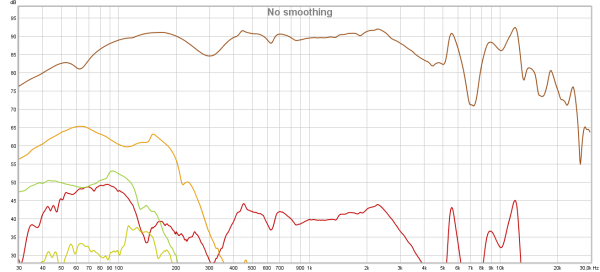
The plot above shows the level differences between the signal (upper trace) and the harmonics.
Most people prefer to see percentages instead of level differences so below the exact same plot except ‘normalized’ to the actual signal and level differences given in percentages. 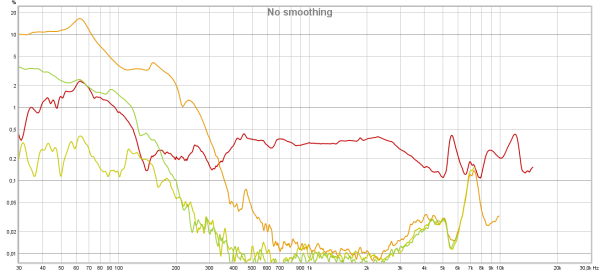
Distortion levels at 90dB SPL are very high. Much higher than one would expect from a 50mm driver. Below 200Hz there is mostly 3rd harmonic distortion and reaches an audible 10% below 80Hz.
Also 5th harmonics are quite high below 150Hz. The fact that 3rd and 5th harmonics are this high indicates compression (soft clipping). 2nd harmonic distortion at 80Hz also reaches 2% at these levels but isn’t as audible. Above 400Hz distortion is quite low.
The actual 2nd harmonic distortion above 1kHz may well be lower than 0.2% . A shortcoming of my measurement rig.
Below the distortion measured at 80dB SPL.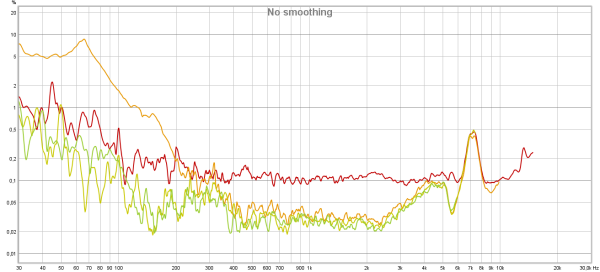
3rd harmonic distortion is still high (5%) but higher order ones dropped to decent levels. In the compression plots there still is compression at 80dB SPL which is also shown in the distortion plot.
Below the CSD (waterfall) plot of the MDR-7509HD. (Left and Right are overlaid)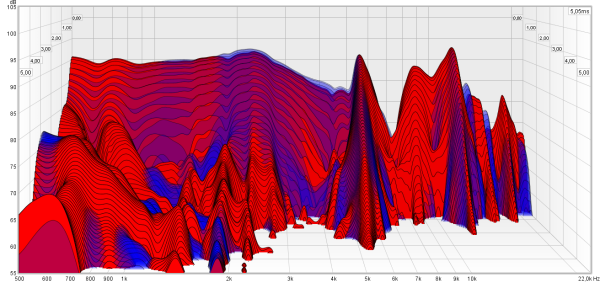 The big driver appears to have lots of resonances below 3kHz and a longer and sharper resonance at 5kHz and at 12kHz.
The big driver appears to have lots of resonances below 3kHz and a longer and sharper resonance at 5kHz and at 12kHz.
Below the Group Delay plot for the MDR-7509HD (Left, Right)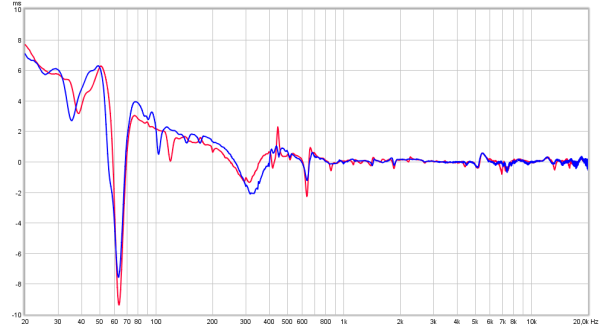
At 60Hz there is a lot of ‘pad bounce’ where 60Hz energy is absorbed by the pads. This is also seen in the frequency response plots by the dip in that area. Given the small ‘air chamber’ in the pad which in reality will be mostly filled with a pinna (outer ear) this will probably be smaller.
A different plot is the spectrum plot. This basically is a CSD (Waterfall) plot but viewed from above where the level differences are color coded instead of being in the vertical axis. Also the frequency range of the spectrum plot is wider (from 100Hz instead of 500Hz). The time span is also bigger in the spectrum plots and expired time is shown from below to top where in the CSD the time is shown from rear to front.
Below the spectrum plot of the MDR-7509HD (Left channel)Here too no problematic behavior is seen.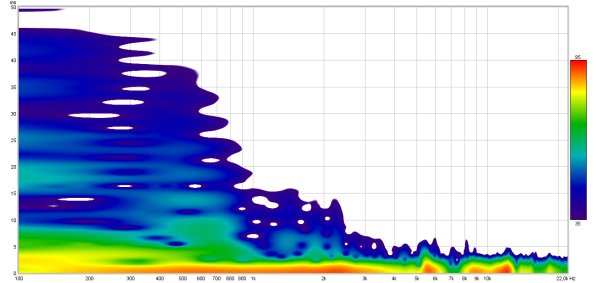 Between 300Hz and 800Hz there is a lot of ‘lingering’ where the frequencies have difficulties decaying fast enough.
Between 300Hz and 800Hz there is a lot of ‘lingering’ where the frequencies have difficulties decaying fast enough.
Step response
Below the step response plot which, when the sound is balanced and well extended should show a fast rise to around 0dB, (indicating fast driver response) and then should be slightly sloping downwards indicating bass extension. (Left, Right)
Bass extension is very poor. The horizontal trace just drops and above 2ms even faster. The initial rise doesn’t reach 0dB and the peak in the first 200μs indicates too much attack and lean lows and mids.
square-wave and impulse response
Below 40Hz and 440Hz square-waves and 100μs impulse response, stimulus (and target) and measured response. The square waves show lows roll-off and sharpness to the sound while the impulse response shows the driver itself is lacking a bit in speed.
The square waves show lows roll-off and sharpness to the sound while the impulse response shows the driver itself is lacking a bit in speed.
conclusion
The Sony MDR-7509HD is suited for monitoring duties in studios and on-site. Not recommended for mixing on it. It can play very loud from just about any source and doesn’t have overwhelming bass nor elevated highs.
Comfort is good but the pads do get sweaty after a while and will flake and degrade over time.
The fixed 3m (stretched) length coiled cable is handy in the studio.
Those that think such purpose made headphones which are used by professionals should thus also sound good for music enjoyment will be sorely disappointed. It does not cut the audiophile mustard.
Bass is lacking and treble quality is mediocre.
The older MDR-7509 seems to be the better liked model as it has more (elevated) bass and warmth.
